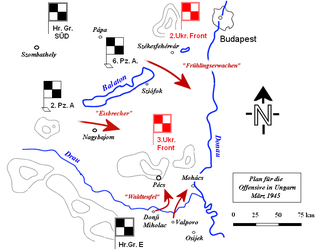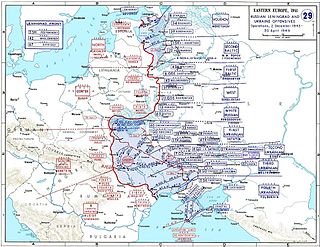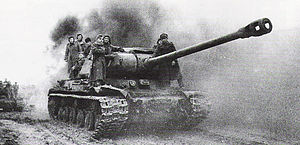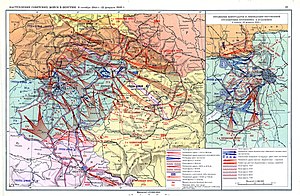
The Battle of Korsun–Cherkassy, or the battle of the Korsun–Cherkasy pocket, was a World War II battle fought from 24 January to 16 February 1944 in the course of the Soviet Dnieper–Carpathian offensive in Ukraine following the Korsun–Shevchenkovsky offensive.

Operation Spring Awakening was the last major German offensive of World War II. The operation was referred to in Germany as the Plattensee Offensive and in the Soviet Union as the Balaton Defensive Operation. It took place in Western Hungary on the Eastern Front and lasted from 6 March until 15 March, 1945. The objective was to secure the last significant oil reserves still available to the European Axis powers and prevent the Red Army from advancing towards Vienna. The Germans failed in their objectives.

Operation Little Saturn was a Red Army offensive on the Eastern Front of World War II that led to battles in Don and Chir rivers region in German-occupied Soviet Union territory in 16–30 December 1942.

The Lvov–Sandomierz offensive or Lvov–Sandomierz strategic offensive operation was a major Red Army operation to force the German troops from Ukraine and Eastern Poland. Launched in mid-July 1944, the operation was successfully completed by the end of August.
The IV SS Panzer Corps was a panzer corps of the Waffen-SS which saw action on the Eastern Front and in the Balkans during World War II.

The Battle of Debrecen, called by the Red Army the Debrecen Offensive Operation, was a battle taking place from 6 to 29 October 1944 on the Eastern Front in Hungary during World War II.

The siege of Budapest or battle of Budapest was the 50-day-long encirclement by Soviet and Romanian forces of the Hungarian capital of Budapest, near the end of World War II. Part of the broader Budapest Offensive, the siege began when Budapest, defended by Hungarian and German troops, was encircled on 26 December 1944 by the Red Army and the Romanian Army. During the siege, about 38,000 civilians died through starvation, military action, and mass executions of Jews by the far-right Hungarian nationalist Arrow Cross Party. The city unconditionally surrendered on 13 February 1945. It was a strategic victory for the Allies in their push towards Berlin.

The 6th Panzer Army was a formation of the German Army, formed in the autumn of 1944. The 6th Panzer Army was first used as an offensive force during the Battle of the Bulge, in which it operated as the northernmost element of the German offensive. The army was subsequently transferred to Hungary in early 1945 and used in both offensive and defensive actions there. The final battles of the 6th Panzer Army were fought in Austria, preventing its fall to Soviet forces. The remnants of the army eventually surrendered to the United States Army. The army's commander throughout its existence, SS-Oberstgruppenführer Josef Dietrich said in early 1945: "We call ourselves the 6th Panzer Army, because we've only got 6 Panzers left."

The Crimean offensive, known in German sources as the Battle of the Crimea, was a series of offensives by the Red Army directed at the German-held Crimea. The Red Army's 4th Ukrainian Front engaged the German 17th Army of Army Group South Ukraine, which consisted of Wehrmacht and Romanian formations. The battles ended with the evacuation of the Crimea by the Germans. German and Romanian forces suffered considerable losses during the evacuation.

The second Jassy–Kishinev offensive, named after the two major cities, Jassy and Kishinev, in the staging area, was a Soviet offensive against Axis forces, which took place in Eastern Romania from 20 to 29 August 1944 during World War II. The 2nd and 3rd Ukrainian Fronts of the Red Army engaged Army Group South Ukraine, which consisted of combined German and Romanian formations, in an operation to reoccupy Bessarabia and destroy the Axis forces in the region, opening the way into Romania and the Balkans.

The Vienna offensive was an offensive launched by the Soviet 2nd and 3rd Ukrainian Fronts in order to capture Vienna, Austria, during World War II. The offensive lasted from 16 March to 15 April 1945. After several days of street-to-street fighting, the Soviet troops captured the city.
The Nagykanizsa–Körmend offensive carried out between 26 March and 15 April 1945 was part of the 3rd Ukrainian Front's Vienna offensive during World War II against the Army Group South forces defending the Kisbajom–Nagykorpád–Nagyatád–Heresznye defensive line north of the Drava river and west of Lake Balaton.

The Kerch–Eltigen operation was a World War II amphibious offensive made in November 1943 by the Red Army as a precursor to the Crimean offensive, with the object of defeating and forcing the withdrawal of the German forces from the Crimea. Landing at two locations on the Crimea's eastern coast, the Red Army successfully reinforced the northern beachhead of Yenikale but was unable to prevent an Axis counterattack that collapsed the southern beachhead at Eltigen. Subsequently, the Red Army used the beachhead at Yenikale to launch further offensive operations into the Crimea in May 1944.

The Dnieper–Carpathian offensive, also known in Soviet historical sources as the Liberation of Right-bank Ukraine, was a strategic offensive executed by the Soviet 1st, 2nd, 3rd, and 4th Ukrainian Fronts, along with the 2nd Belorussian Front, against the German Army Group South, Army Group A and elements of Army Group Center, and fought from late December 1943 to early May 1944. The battles in right-bank Ukraine and in the Crimea were the most important event of the 1944 winter-spring campaign on the Eastern Front.
This order of battle lists the German, Hungarian, Romanian, and Soviet forces involved in the Battle of Debrecen in October 1944.

The Belgorod–Kharkov strategic offensive operation, or simply Belgorod–Kharkov offensive operation, was a Soviet strategic summer offensive that aimed to recapture Belgorod and Kharkov, and destroy Nazi German forces of the 4th Panzer Army and Army Detachment Kempf. The operation was codenamed Operation Polkovodets Rumyantsev, after the 18th-century Field Marshal Peter Rumyantsev and was conducted by the Voronezh and Steppe Fronts in the southern sector of the Kursk Bulge. The battle was referred to as the Fourth Battle of Kharkov by the Germans.

The 7th Mechanized Corps was a mechanized corps of the Red Army, formed three times. The corps was first formed in 1934 in the Leningrad Military District and was converted into the 10th Tank Corps in 1938. The corps was reformed in the summer of 1940 in the Moscow Military District and fought in the Battle of Smolensk, after which its headquarters became part of Group Yartsevo's headquarters. The corps was formed a third time in August and September 1943. The third formation fought in the Dnieper–Carpathian Offensive, Uman–Botoșani Offensive, Second Jassy–Kishinev Offensive, Battle of Debrecen, Budapest Offensive, Bratislava–Brno Offensive, Prague Offensive, and the Soviet invasion of Manchuria. Postwar, the corps' third formation became a division and was disbanded in 1957.

Operation Konrad III was a German military offensive on the Eastern Front of the Second World War. It was the third and most ambitious of the three Konrad Operations and had the objective of relieving the siege of Budapest and recapturing the entire Transdanubia region. Achieving complete surprise, the German offensive began on 18 January 1945. Supported by the Luftwaffe, the IV SS Panzer Corps, the principal German attack formation, overran the Soviet 4th Guards Army in two days, destroying hundreds of Soviet tanks along the way, reached the Danube river on 19 January and recaptured 400 square kilometers of territory in four days. After nine days of combat, and the destruction by the SS of two-thirds of Soviet tanks in the entire 3rd Ukrainian Front, the German offensive was stopped by Soviet reinforcements 25 kilometers short of Budapest on 26 January.
The 109th Guards Rifle Division was formed as an elite infantry division of the Red Army in July 1943, based on the 6th Guards Rifle Brigade and the 9th Guards Rifle Brigade and was the second of a small series of Guards divisions formed on a similar basis. It was considered a "sister" to the 108th Guards Rifle Division and they fought along much the same combat paths until the spring of 1945.















